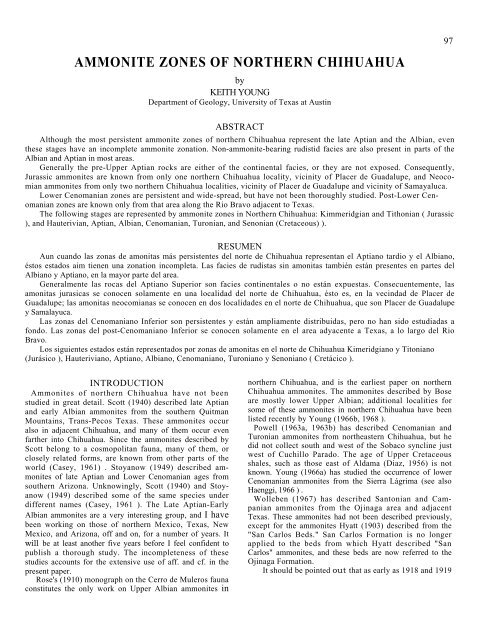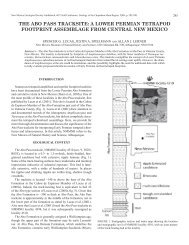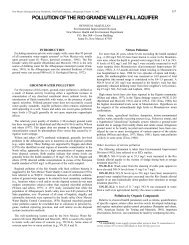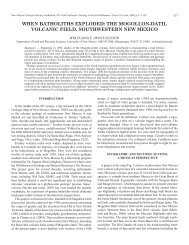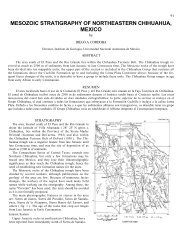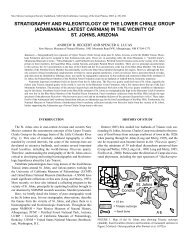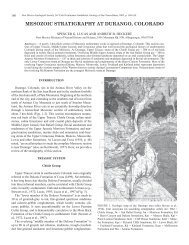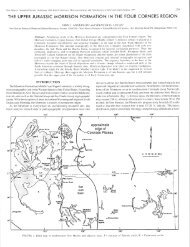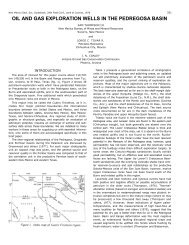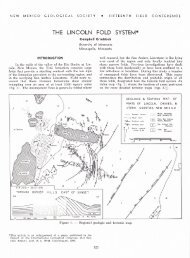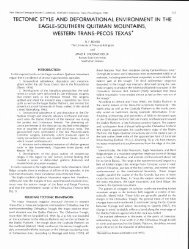Ammonite zones of northern Chihuahua - New Mexico Geological ...
Ammonite zones of northern Chihuahua - New Mexico Geological ...
Ammonite zones of northern Chihuahua - New Mexico Geological ...
Create successful ePaper yourself
Turn your PDF publications into a flip-book with our unique Google optimized e-Paper software.
AMMONITE ZONES OF NORTHERN CHIHUAHUA<br />
by<br />
KEITH YOUNG<br />
Department <strong>of</strong> Geology, University <strong>of</strong> Texas at Austin<br />
ABSTRACT<br />
Although the most persistent ammonite <strong>zones</strong> <strong>of</strong> <strong>northern</strong> <strong>Chihuahua</strong> represent the late Aptian and the Albian, even<br />
these stages have an incomplete ammonite zonation. Non-ammonite-bearing rudistid facies are also present in parts <strong>of</strong> the<br />
Albian and Aptian in most areas.<br />
Generally the pre-Upper Aptian rocks are either <strong>of</strong> the continental facies, or they are not exposed. Consequently,<br />
Jurassic ammonites are known from only one <strong>northern</strong> <strong>Chihuahua</strong> locality, vicinity <strong>of</strong> Placer de Guadalupe, and Neocomian<br />
ammonites from only two <strong>northern</strong> <strong>Chihuahua</strong> localities, vicinity <strong>of</strong> Placer de Guadalupe and vicinity <strong>of</strong> Samayaluca.<br />
Lower Cenomanian <strong>zones</strong> are persistent and wide-spread, but have not been thoroughly studied. Post-Lower Cenomanian<br />
<strong>zones</strong> are known only from that area along the Rio Bravo adjacent to Texas.<br />
The following stages are represented by ammonite <strong>zones</strong> in Northern <strong>Chihuahua</strong>: Kimmeridgian and Tithonian ( Jurassic<br />
), and Hauterivian, Aptian, Albian, Cenomanian, Turonian, and Senonian (Cretaceous) ).<br />
RESUMEN<br />
Aun cuando las zonas de amonitas más persistentes del norte de <strong>Chihuahua</strong> representan el Aptiano tardio y el Albiano,<br />
éstos estados aim tienen una zonation incompleta. Las facies de rudistas sin amonitas también están presentes en partes del<br />
Albiano y Aptiano, en la mayor parte del area.<br />
Generalmente las rocas del Aptiano Superior son facies continentales o no están expuestas. Consecuentemente, las<br />
amonitas jurasicas se conocen solamente en una localidad del norte de <strong>Chihuahua</strong>, ésto es, en la vecindad de Placer de<br />
Guadalupe; las amonitas neocomianas se conocen en dos localidades en el norte de <strong>Chihuahua</strong>, que son Placer de Guadalupe<br />
y Samalayuca.<br />
Las zonas del Cenomaniano Inferior son persistentes y están ampliamente distribuidas, pero no han sido estudiadas a<br />
fondo. Las zonas del post-Cenomaniano Inferior se conocen solamente en el area adyacente a Texas, a lo largo del Rio<br />
Bravo.<br />
Los siguientes estados están representados por zonas de amonitas en el norte de <strong>Chihuahua</strong> Kimeridgiano y Titoniano<br />
(Jurásico ), Hauteriviano, Aptiano, Albiano, Cenomaniano, Turoniano y Senoniano ( Cretácico ).<br />
INTRODUCTION<br />
<strong>Ammonite</strong>s <strong>of</strong> <strong>northern</strong> <strong>Chihuahua</strong> have not been<br />
studied in great detail. Scott (1940) described late Aptian<br />
and early Albian ammonites from the southern Quitman<br />
Mountains, Trans-Pecos Texas. These ammonites occur<br />
also in adjacent <strong>Chihuahua</strong>, and many <strong>of</strong> them occur even<br />
farther into <strong>Chihuahua</strong>. Since the ammonites described by<br />
Scott belong to a cosmopolitan fauna, many <strong>of</strong> them, or<br />
closely related forms, are known from other parts <strong>of</strong> the<br />
world (Casey, 1961) . Stoyanow (1949) described ammonites<br />
<strong>of</strong> late Aptian and Lower Cenomanian ages from<br />
southern Arizona. Unknowingly, Scott (1940) and Stoyanow<br />
(1949) described some <strong>of</strong> the same species under<br />
different names (Casey, 1961 ). The Late Aptian-Early<br />
Albian ammonites are a very interesting group, and I have<br />
been working on those <strong>of</strong> <strong>northern</strong> <strong>Mexico</strong>, Texas, <strong>New</strong><br />
<strong>Mexico</strong>, and Arizona, <strong>of</strong>f and on, for a number <strong>of</strong> years. It<br />
will be at least another five years before I feel confident to<br />
publish a thorough study. The incompleteness <strong>of</strong> these<br />
studies accounts for the extensive use <strong>of</strong> aff. and cf. in the<br />
present paper.<br />
Rose's (1910) monograph on the Cerro de Muleros fauna<br />
constitutes the only work on Upper Albian ammonites in<br />
97<br />
<strong>northern</strong> <strong>Chihuahua</strong>, and is the earliest paper on <strong>northern</strong><br />
<strong>Chihuahua</strong> ammonites. The ammonites described by Bose<br />
are mostly lower Upper Albian; additional localities for<br />
some <strong>of</strong> these ammonites in <strong>northern</strong> <strong>Chihuahua</strong> have been<br />
listed recently by Young (1966b, 1968 ).<br />
Powell (1963a, 1963b) has described Cenomanian and<br />
Turonian ammonites from northeastern <strong>Chihuahua</strong>, but he<br />
did not collect south and west <strong>of</strong> the Sobaco syncline just<br />
west <strong>of</strong> Cuchillo Parado. The age <strong>of</strong> Upper Cretaceous<br />
shales, such as those east <strong>of</strong> Aldama (Diaz, 1956) is not<br />
known. Young (1966a) has studied the occurrence <strong>of</strong> lower<br />
Cenomanian ammonites from the Sierra Lágrima (see also<br />
Haenggi, 1966 ) .<br />
Wolleben (1967) has described Santonian and Campanian<br />
ammonites from the Ojinaga area and adjacent<br />
Texas. These ammonites had not been described previously,<br />
except for the ammonites Hyatt (1903) described from the<br />
"San Carlos Beds." San Carlos Formation is no longer<br />
applied to the beds from which Hyatt described "San<br />
Carlos" ammonites, and these beds are now referred to the<br />
Ojinaga Formation.<br />
It should be pointed out that as early as 1918 and 1919
98 NEW MEXICO GEOLOGICAL SOCIETY-TWENTIETH FIELD CONFERENCE<br />
W. T. Keller had a group <strong>of</strong> Swiss geologists in <strong>northern</strong><br />
<strong>Chihuahua</strong>, working for "El Aguila" (La Compania de<br />
Méxicana de Shell ). Keller collected Campanian fossils in<br />
the vicinity <strong>of</strong> Ojinaga and La Mula, and Jurassic fossils at<br />
San Sostenes. These fossils were taken to Tampico and were<br />
eventually deposited in the University <strong>of</strong> Texas collections<br />
as the "El Aguila" part <strong>of</strong> the W. S. Adkins collection.<br />
These fossils had also been seen by Burkhardt (1933) and<br />
still accompany a label bearing the name <strong>of</strong> the collector,<br />
the date, and the locality.<br />
REMARKS ON<br />
AMMONITE ZONATION<br />
The ammonite <strong>zones</strong> <strong>of</strong> Tables 1 and 2 are incomplete.<br />
There are three reasons for incomplete ammonite zonation:<br />
(1) collection failure, (2) wrong environment, e. g., ammonites<br />
are not found in non-marine rocks, nor are they<br />
found in rudistid-bearing strata, and ( 3) lacunae. The first<br />
two examples appear to be mainly responsible for the<br />
absence <strong>of</strong> many ammonite <strong>zones</strong> in <strong>northern</strong> <strong>Chihuahua</strong>.<br />
JURASSIC ZONES<br />
I have listed only two Jurassic <strong>zones</strong> from <strong>northern</strong> <strong>Chihuahua</strong>.<br />
W. S. Adkins and R. E. King collected the fossils,<br />
and Imlay (1943) described them. However, there may be<br />
more than two <strong>zones</strong>, as indicated by the age comparisons<br />
<strong>of</strong> Imlay (1943, p. 529) .<br />
The absence <strong>of</strong> Upper Kimmeridgian and Lower Tithonian<br />
<strong>zones</strong> in the Placer de Guadalupe area is probably<br />
the result <strong>of</strong> collection failure in rocks that do not abound<br />
with fossils. Upper Tithonian and Lower Neocomian<br />
(Berriasian and Valanginian <strong>zones</strong>) are likwise probably<br />
absent by collection failure in this vicinity; they could be<br />
cut out by complex structure, or these slightly fossiliferous<br />
beds may not as yet have yielded fossils. No one has found<br />
a Jurassic-Cretaceous unconformity in this area, but I must<br />
admit that not many have tried. Fossils <strong>of</strong> the Kossmatia<br />
rancheriaensis Imlay zone also occur in the Jurassic Malone<br />
Formation <strong>of</strong> the Malone Mountains; the specimen that I<br />
have identified is a Kossmatia kingi Imlay. Otherwise, the<br />
Jurassic is not known north or northeast <strong>of</strong> the vicinity <strong>of</strong><br />
Placer de Guadalupe, unless the Jurassic at Sierra de Ojo<br />
Caliente, stop 4 <strong>of</strong> trip A-13, 20th International <strong>Geological</strong><br />
Congress (Diaz, 1956, p. 312, Fig. 4) has been correctly<br />
dated.<br />
CRETACEOUS ZONES<br />
The collection in the summer <strong>of</strong> 1968 by D. S. Webb <strong>of</strong><br />
a good specimen <strong>of</strong> Leopoldia victoriensis Imlay (1938)<br />
from the sandstones along the highway south <strong>of</strong> Samalayuca<br />
has changed the age <strong>of</strong> these rocks, formerly reported as<br />
Jurassic by William E. Humphrey (Diaz, 1956, p. 28) on<br />
field identification only. These rocks are lower Hauterivian.<br />
The same rocks with the same fossils occur at Placer de<br />
Guadalupe where Bridges (1962, 1965, pp. 74-76) reported<br />
them as Jurassic because I made misidentifications similar<br />
to Humphrey's. An isolated specimen, in different lithology,<br />
<strong>of</strong> Leopoldia sp. cf. leopoldinus (d'Orbigny), collected by<br />
DeFord from near the picachos in the vicinity <strong>of</strong> Placer de<br />
Guadalupe, likewise is lower Hauterivian. Two Lower Cretaceous<br />
ammonites (presumably pre-Aptian) are rumored<br />
to have come from near Cuchillo Parado, but these seem to<br />
be misplaced. No pre-Aptian ammonites from <strong>northern</strong><br />
<strong>Chihuahua</strong>, other than those mentioned above, are known<br />
to the writer.<br />
Jurassic and Cretaceous fossils are reported at Sierra de<br />
Ojo Caliente (Diaz, 1956, p. 26, 31, 32 ). I have seen no<br />
identifiable fossils from this locality.<br />
The absence <strong>of</strong> upper Hauterivian, Barremian, and most<br />
<strong>of</strong> the Lower Aptian ammonites from <strong>northern</strong> <strong>Chihuahua</strong><br />
can usually be attributed to the occurrence <strong>of</strong> the wrong<br />
facies. In many localities the Navarette evaporite section is<br />
overlain by continental deposits, as on the west flank <strong>of</strong> the<br />
Sierra de la Aldea, east <strong>of</strong> Cuchillo Parado. At this locality,<br />
above the evaporites, pulmonate land snails have been collected<br />
by Young, Powell, Diaz, and DeFord. In the southern<br />
Quitman Mountains, dinosaur bones were collected by<br />
Donald Campbell (1968) and Bill Jones (1968) from the<br />
Las Vigas formation. How much <strong>of</strong> the Las Vigas Formation<br />
is terrestrial is debatable, but the Las Vigas and Navarette<br />
formations certainly represent environments inhospitable<br />
to ammonites.<br />
The first ammonites above the lower Hauterivian represent<br />
the latest Lower Aptian. These are Cheloniceras sp.,<br />
one specimen from the Sierra del Presidio; Cheloniceras<br />
adkinsi Scott, from the southern Quitman Mountains,<br />
which may not be a Cheloniceras; and a specimen <strong>of</strong> Cheloniceras<br />
from just above the redbed sequence on the east<br />
flank <strong>of</strong> Sierra Cuervo, north <strong>of</strong> Aldama. Only in these<br />
three areas have probable late Lower Aptian fossils been<br />
collected.<br />
Upper Aptian fossils are well known in <strong>northern</strong> <strong>Chihuahua</strong><br />
and adjacent Trans-Pecos Texas (Table 1).<br />
The zone <strong>of</strong> Dufrenoyia justinae (Hill) is not as widespread<br />
as heret<strong>of</strong>ore assumed, since myself and others have<br />
misidentified Hypacanthoplites bakeri Scott as D. justinae<br />
on more than one occasion. In addition, the Dufrenovia<br />
justinae zone may represent other <strong>zones</strong> too, but the geological<br />
sections have not been collected in detail, and none<br />
have received the type <strong>of</strong> study necessary to produce exact<br />
collections.<br />
Overlying the zone <strong>of</strong> Dufrenoyia justinae in the southern<br />
Quitman Mountains <strong>of</strong> Trans-Pecos Texas, the Sierra<br />
del Presidio, and the Bisbee district <strong>of</strong> southeastern Arizona<br />
is the zone <strong>of</strong> Kazanskyella trinitense (Scott). Finer collecting<br />
may also produce a more detailed zonation at this level.<br />
This fauna has not been collected to the south <strong>of</strong> these<br />
areas, probably because it is replaced by the late Aptianlower<br />
Albian rudistid complex. Gillerman (1958, pp. 47-50)<br />
collected a fauna <strong>of</strong> approximately the same age from the<br />
Carbonate Hill Limestone in the central Peloncillo Mountains.<br />
Some <strong>of</strong> his specimens seem to be closely related to<br />
Kazanskyella n. sp. from the Bexar Shale in the Spahn well<br />
in Gonzales County, south Texas. I also have a good specimen<br />
<strong>of</strong> Kazanskyella trinitense (Scott) from the Sierra de<br />
Sabinas-Lampazos, northwest <strong>of</strong> Sabinas Hidalgo, Nuevo<br />
Leon.<br />
The Lower Albian zone <strong>of</strong> Hypacanthoplites bakeri Scott
NEW MEXICO GEOLOGICAL SOCIETY-TWENTIETH FIELD CONFERENCE 99<br />
is widespread. In addition to the localities mentioned<br />
(Table 1), H. bakeri Scott was collected by R. E. King and<br />
W. S. Adkins at Cerro Chino, north <strong>of</strong> Coyame, and by<br />
Haenggi, Young, Gries, and Heiken, on the east flank <strong>of</strong><br />
the Sierra Lágrima, opposite Rancho la Bomba.<br />
The zone <strong>of</strong> Quitmanites ceratitosus ( Scott) seems to lie<br />
between the zone <strong>of</strong> Douvilleiceras and the zone <strong>of</strong> Hypacanthoplites<br />
bakeri. Collecting has not been in sufficient<br />
detail to verify this additional zone, especially since Scott's<br />
(1940, pp. 981-984) Locality MI would seem to range<br />
through at least three <strong>zones</strong>.<br />
The zone <strong>of</strong> Douvilleiceras mammilatum s.I. is wideranging<br />
throughout much <strong>of</strong> the world at the base <strong>of</strong> the<br />
middle Albian. The zone <strong>of</strong> D. mamilatum s.l. probably<br />
includes the zone <strong>of</strong> "Sonneratia" whitneyi Scott. Therefore<br />
I have used two <strong>zones</strong>, "S." whitneyi above and Douvilleiceras<br />
quitmanensis below. "Sonneratia" whitneyi is<br />
not a Sonneratia, and may turn out to be a special <strong>of</strong>fshoot<br />
<strong>of</strong> Hypacanthoplites with flexuous ribs. Its occurrence with<br />
Hypacanthoplites n.sp. is apparently another example <strong>of</strong><br />
endemic species <strong>of</strong> relict genera behind the Texas-<strong>Mexico</strong><br />
barrier reef system (Young, 1966a, 1969) . In this zone<br />
endemic species <strong>of</strong> Hypacanthoplites range into rocks<br />
younger than those represented for the genus in other parts<br />
<strong>of</strong> the world.<br />
Except for a clay-marl facies at Banco Lucero (Webb,<br />
D. S., 1969, personal communication) apparently extending<br />
into the region from the southwest, the remainder <strong>of</strong><br />
the Middle Albian in <strong>northern</strong> <strong>Chihuahua</strong> is represented<br />
by reef facies (Finlay Limestone, etc.) . Webb has collected,<br />
from the pinchout <strong>of</strong> the clay-marl facies, a couple <strong>of</strong> small<br />
ammonites that appear to be related to Tegoceras, but they<br />
are poorly preserved and more specimens are needed before<br />
a zone can be set up.<br />
The next overlying ammonite zone is the zone <strong>of</strong> Manuaniceras<br />
powelli Young, which represents the base <strong>of</strong> the<br />
Upper Albian. Fossils <strong>of</strong> this zone have been found only<br />
at the north end <strong>of</strong> the Sierra del Presidio (Rancherias, collected<br />
by Diaz and others in 1945) and in the southern<br />
Quitman Mountains (collected by T. W. Stanton, and<br />
later by Bill Jones). The fossils collected by Diaz and others<br />
and T. W. Stanton are in the United States National<br />
Museum. The fossils collected by Bill Jones are in the collections<br />
at The University <strong>of</strong> Texas. South <strong>of</strong> these areas<br />
rudistid facies <strong>of</strong> this age appear to be more complete, and<br />
ammonites have not been recovered.<br />
The <strong>zones</strong> <strong>of</strong> Adkinsites bravoensis (Bose) and Boeseites<br />
romeri (Haas) are widespread from the vicinity <strong>of</strong><br />
Placer de Guadalupe to the north into Texas and to the<br />
east into Nuevo Leon (Young, 1966b, 1968). In <strong>northern</strong><br />
<strong>Chihuahua</strong> they occur in the Benevides Formation. The<br />
occurrence <strong>of</strong> the overlying zone <strong>of</strong> Pervinquieria equi-
100 NEW MEXICO GEOLOGICAL SOCIETY-TWENTIETH FIELD CONFERENCE<br />
distans (Cragin ) is spotty, however, being replaced by<br />
rudistid facies in most areas. Rudistid facies occupy the interval<br />
between the <strong>zones</strong> <strong>of</strong> P. equidistans and Plesioturrilites<br />
brazoensis (Romer), and in some areas even replace the<br />
P. brazoensis zone. An exception to this statement is an<br />
area generally north <strong>of</strong> the rudistid facies <strong>of</strong> this age, from<br />
which Bose (1910) described the Cerro de Muleros fauna.<br />
The boundary between the Upper and Lower Cretaceous<br />
(Albian-Cenomanian) is at the base <strong>of</strong> the P. brazoensis<br />
zone and is gradational throughout the area.<br />
The Del Rio Claystone and Buda Limestone <strong>zones</strong> are<br />
Lower Cenomanian and include the zone <strong>of</strong> Graysonites<br />
lozoi Young in the Del Rio and the zone <strong>of</strong> Budaiceras<br />
hyatti (Shattuck) in the Buda Limestone.<br />
The post-lower Cenomanian <strong>zones</strong> are restricted to that<br />
part <strong>of</strong> <strong>Chihuahua</strong> along the Rio Bravo next to Texas, except<br />
for a bed <strong>of</strong> Spathites in the Ojinaga Shale in the<br />
Sobaco syncline west <strong>of</strong> Cuchillo Parado (Powell, I. Dan,<br />
personal communication). The presumably Upper Creta-<br />
ceous shales some 20 miles by road toward Ciudad <strong>Chihuahua</strong><br />
from Placer de Guadalupe have not yet yielded fossils<br />
(Diaz, 1956, p. 34). Eventually some <strong>of</strong> the <strong>zones</strong> <strong>of</strong> the<br />
Ojinaga Formation may be found in the synclines <strong>of</strong><br />
<strong>northern</strong> <strong>Chihuahua</strong>.<br />
SUMMARY<br />
In summary, I would like to point out that the above<br />
zonation is, as yet, highly incomplete. Detailed sections<br />
need to be measured, and many, many more fossils need to<br />
be collected before the zonal scheme can become entirely<br />
satisfactory. In addition, there is a great opportunity to<br />
collect rudists from the more massive limestone formations<br />
between the ammonite <strong>zones</strong>. Rudistid <strong>zones</strong> can then be<br />
intercalated with the ammonite <strong>zones</strong> so that a rudistidammonite<br />
zonation may be compiled that will be satisfac-
NEW MEXICO GEOLOGICAL SOCIETY-TWENTIETH FIELD CONFERENCE 101<br />
tory for the entire <strong>northern</strong> <strong>Chihuahua</strong> area and adjacent<br />
Trans-Pecos Texas. The zonation presented here is the most<br />
reasonable for the present data, but can easily be altered<br />
with future data and more time.<br />
REFERENCES<br />
Bose, Emil, 1910, Monografia geolOgica y paleontológia del Cerro de<br />
Muleros circa de cuidad Juarez, Estado de <strong>Chihuahua</strong> y descripcion<br />
de la fauna Cretácea de la Encantada, Placer de Guadalupe, Estado<br />
de <strong>Chihuahua</strong>, <strong>Mexico</strong>: Inst. Geol. <strong>Mexico</strong> Bol., no. 25, vi + 193<br />
pp., 48 pls., + maps and cross-sections.<br />
Bridges, L. W., 1962, Geology <strong>of</strong> Mina Plumosas Area, <strong>Chihuahua</strong>,<br />
<strong>Mexico</strong>: Univ. <strong>of</strong> Texas, dissertation, 241 pp., + appendix, 34 figs.,<br />
3 pls., 11 tbls.<br />
, 1965, Geologia del Area de Plomosas, <strong>Chihuahua</strong>: pp. 1-<br />
134, figs. 1-21, maps 1-3, tbls. 1-11, in BRIDGES, L. W., &<br />
ZOLTAN DE CSERNA, Estudios Geológicos en el Estado de <strong>Chihuahua</strong>:<br />
Inst. Geol. <strong>Mexico</strong> Bol., no. 74, 148 pp., il. [translated by<br />
Diego A. Cordoba].<br />
Burckhardt, Carlos, 1930, etude synthetique sur le Mesozoique Mexicain:<br />
Soc. PaMont. Suisse, Mem., v. 49 & 50, 280 pp., il.<br />
Campbell, D. H., 1968, Petrology <strong>of</strong> the Early Cretaceous Yucca<br />
Formation, Southern Quitman Mountains and Vicinity, Trans-<br />
Pecos Texas: Texas A&M Univ., dissertation, xvi 323 pp., 16 figs.,<br />
11 pls.<br />
Casey, Raymond, 1961, The Stratigraphical Paleontology <strong>of</strong> the<br />
Lower Greensand: Paleontology, v. 3, pp. 487-621, 14 text figs.,<br />
pls. 77-84.<br />
Diaz, Teodoro, 1956, Ruta: Cuidad Juarez, <strong>Chihuahua</strong>, Chih.: pp.<br />
23-32, 4 figs., in DIAZ, TEODORO, ET AL., Estratigrafia Mesozoica<br />
y Tectónica de la Sierra de <strong>Chihuahua</strong>: Pérmico de Placer de<br />
Guadalupe, Chih.: Geohidrologia de la Region Lagunera: Estratigrafia<br />
Mesozoica y Tectónica de la Sierra Madre Oriental entre<br />
Mapimi, Dgo. y Monterrey, N. L.: Congreso Geol. Internacional,<br />
Excursion A-13, 120 pp., il.<br />
Gillerman, Elliot, 1958, Geology <strong>of</strong> the Central Peloncillo Mountains,<br />
Hidalgo County, <strong>New</strong> <strong>Mexico</strong>, and Cochise County, Arizona:<br />
<strong>New</strong> <strong>Mexico</strong> Bur. <strong>of</strong> Mines and Mineral Resources, Bull. 57, 152<br />
pp., 1 fig., 14 pls., 2 tbls.<br />
Haenggi, Walter T., 1966, Geology <strong>of</strong> El Cuervo Area, Northeastern<br />
<strong>Chihuahua</strong>, <strong>Mexico</strong>: University <strong>of</strong> Texas dissertation, 401 pp., 37<br />
figs., 7 pls., 22 tbls.<br />
Hyatt, Alpheus, 1903, Pseudoceratites <strong>of</strong> the Cretaceous: U.S. Geol.<br />
Survey, Monograph 44, 351 pp., 47 pls. (ed. by T. W. Stanton ).<br />
Imlay, Ralph W., 1938, <strong>Ammonite</strong>s <strong>of</strong> the Taraises Formation <strong>of</strong><br />
Northern <strong>Mexico</strong>: Geol. Soc. Am., Bull. v. 49, pp. 539-602, 4 figs.,<br />
15 pls.<br />
, 1940, Neocomian Faunas <strong>of</strong> Northern <strong>Mexico</strong>: Geol. Soc.<br />
Am. Bull., v. 51, pp. 117-190, 7 figs., 21 pls.<br />
, 1943, Upper Jurassic <strong>Ammonite</strong>s from the Placer de<br />
Guadalupe District, <strong>Chihuahua</strong>, <strong>Mexico</strong>: Jour. Paleo., vol. 17, pp.<br />
527-654, 1 text fig., pls. 87-95.<br />
Jones, B. R., 1968, Geology <strong>of</strong> the Southern Quitman Mountains and<br />
vicinity, Hudspeth County, Texas: Texas A&M Univ., dissertation,<br />
162 pp., il.<br />
Powell, J. Dan, 1963a, Cenomanian-Turonian (Cretaceous) <strong>Ammonite</strong>s<br />
from Trans-Pecos Texas and northeastern <strong>Chihuahua</strong>,<br />
<strong>Mexico</strong>: Jour. Paleontology, v. 37, pp. 309-322, 3 figs., pls. 31-34.<br />
, 1963b, Turonian (Cretaceous) <strong>Ammonite</strong>s from northeastern<br />
<strong>Chihuahua</strong>, <strong>Mexico</strong>: Jour. Paleontology, v. 37, pp. 1217-<br />
1232, 6 text-figs., pls., 166-171.<br />
Ramirez, M. Jaime C., and Francisco Acevedo C., 1957, Notas Sobre<br />
la Geologia de <strong>Chihuahua</strong>: Assoc. Mexicana de Geológos Petroleros,<br />
v. 9, pp. 583-770, 61 figs., 7 tbls., 6 strat. columns.<br />
Scott, Gayle, 1940, Cephalopods from the Cretaceous Trinity Group<br />
<strong>of</strong> the south-central United States: The Univ. <strong>of</strong> Texas Publ. 3945,<br />
pp. 969-1125, figs. 138-179, pls. 55-68.<br />
Stoyanow, Alexander, 1949, Lower Cretaceous Stratigraphy in southeastern<br />
Arizona: Geol. Soc. Am. Memoir 38, 169 pp., 27 pls., 7<br />
tbls.<br />
Wolleben, J. A., 1967, Senonian (Cretaceous) Mollusca from Trans-<br />
Pecos Texas and northeastern <strong>Chihuahua</strong>, <strong>Mexico</strong>: Jour. Paleontology,<br />
v.41, pp. 1150-1165, 8 text figs., pls. 147-152.<br />
Young, Keith, 1966a, Relict Lyellicerid Fauna <strong>of</strong> Texas and Northern<br />
<strong>Mexico</strong>: Program, Am. Assoc. Petro. Geol., 51st Ann Meeting, p.<br />
116.<br />
, 1966b, Texas Mojsisovicziinae (Ammonoidea ) and the<br />
zonation <strong>of</strong> the Fredericksburg: Geol. Soc. Am. Memoir 100, viii<br />
+ 225 pp., 21 figs., 38 pls., 5 tbls.<br />
, 1968, Upper Albian (Cretaceous, M. romeri zone) am-<br />
monites in Texas and <strong>Mexico</strong>: Jour. Paleontology, v. 42, pp. 70-80,<br />
1 text fig., pls., 15-19.<br />
, 1969, Comanchean Barrier Reefs and Endemism <strong>of</strong> Co-<br />
manchean Faunas: Carribean Geol. Assoc., 21 pp., 4 figs., 2 tbls.<br />
[in press].


